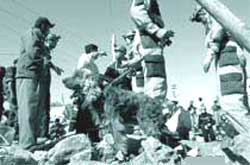No signs of science
 D eath and earthquakes do not come by appointment. However, an earthquake gives definitive indications of its arrival. In Gujarat, there were many. A 4.2 magnitude quake rocked the Rann of Kachhch on December 24, 2000. Its epicentre was 22 km away from Bhuj. Bhavnagar, near Bhuj, also felt several tremors before that. These tremors should have been wake-up calls for Indian scientists. But seismologists never took these tremors seriously. Similarly, the Killari earthquake of Latur in September 1993 was preceded by several tremors over a period of five months. Gujarat has a tryst with earthquakes. Every 30 years, it experiences a major one: Bhavnagar in 1872, Kachhch in 1903, Dwarka in 1940, Bharuch in 1970 and Bhuj in 2001. "If a region has a history of earthquakes, then it is earthquake prone,' says R S Dattatrayan, director, seismological division, Indian Meteorological Department (imd), New Delhi.
D eath and earthquakes do not come by appointment. However, an earthquake gives definitive indications of its arrival. In Gujarat, there were many. A 4.2 magnitude quake rocked the Rann of Kachhch on December 24, 2000. Its epicentre was 22 km away from Bhuj. Bhavnagar, near Bhuj, also felt several tremors before that. These tremors should have been wake-up calls for Indian scientists. But seismologists never took these tremors seriously. Similarly, the Killari earthquake of Latur in September 1993 was preceded by several tremors over a period of five months. Gujarat has a tryst with earthquakes. Every 30 years, it experiences a major one: Bhavnagar in 1872, Kachhch in 1903, Dwarka in 1940, Bharuch in 1970 and Bhuj in 2001. "If a region has a history of earthquakes, then it is earthquake prone,' says R S Dattatrayan, director, seismological division, Indian Meteorological Department (imd), New Delhi.
Scientists attribute frequent earthquakes to the expansion of the Indian Ocean sea floor at the rate of five centimetres (cm) every year and the rotation of the Saurashtra region in an anti-clockwise direction. Most earthquakes in India are driven by the
Related Content
- United in science 2021: a multi-organization high-level compilation of the latest climate science information
- Symbolic representation of numerosity by honeybees (Apis mellifera): matching characters to small quantities
- India, African Union ink MoU on health sciences cooperation
- Energy auditing: case study of Karnataka
- Energy auditing: case study of Karnataka
- Ghana: EPA, Indian Firm Sign MOU
